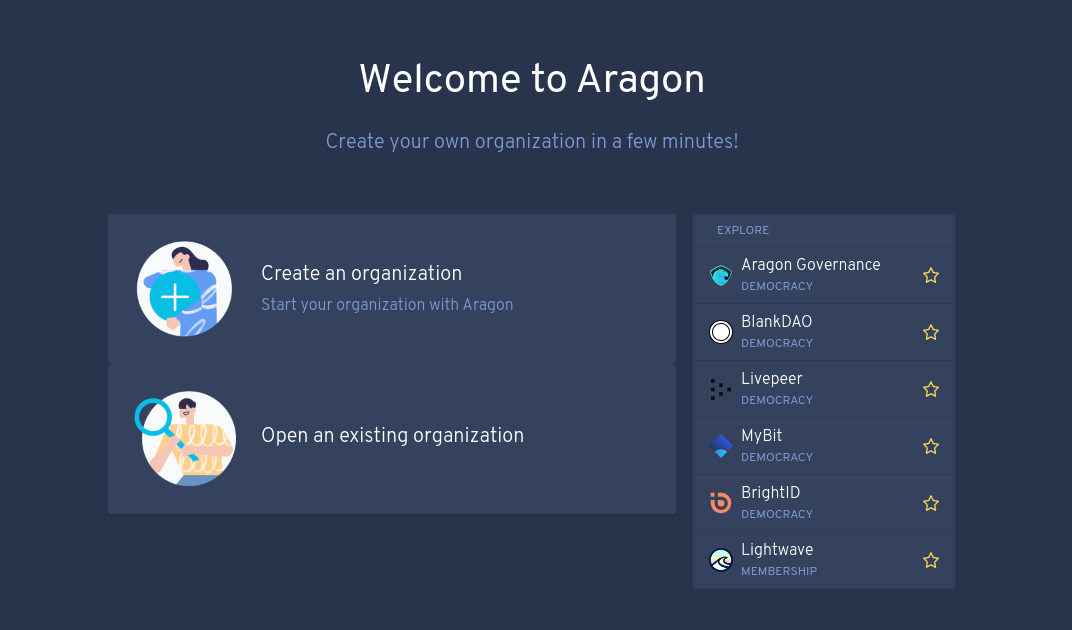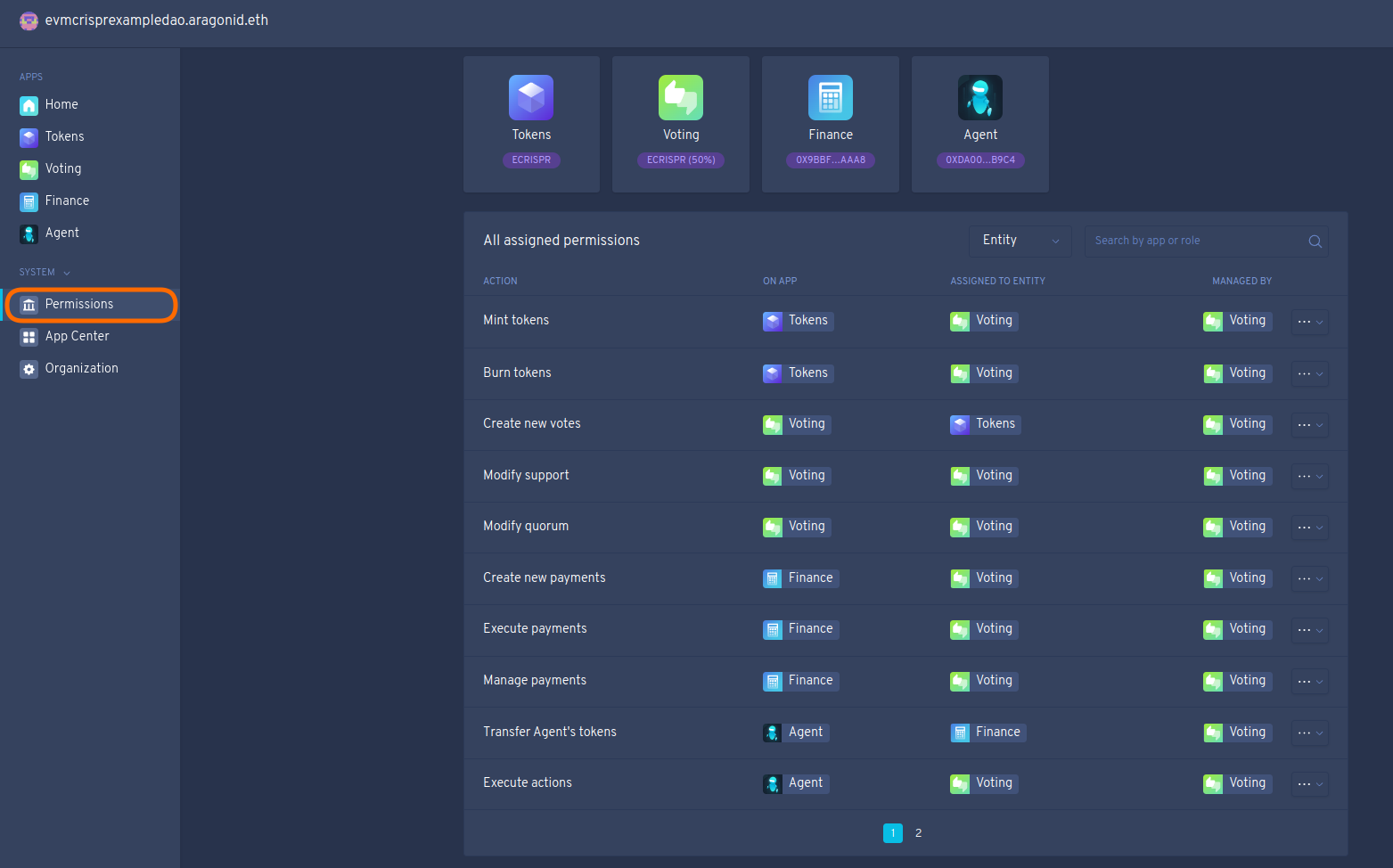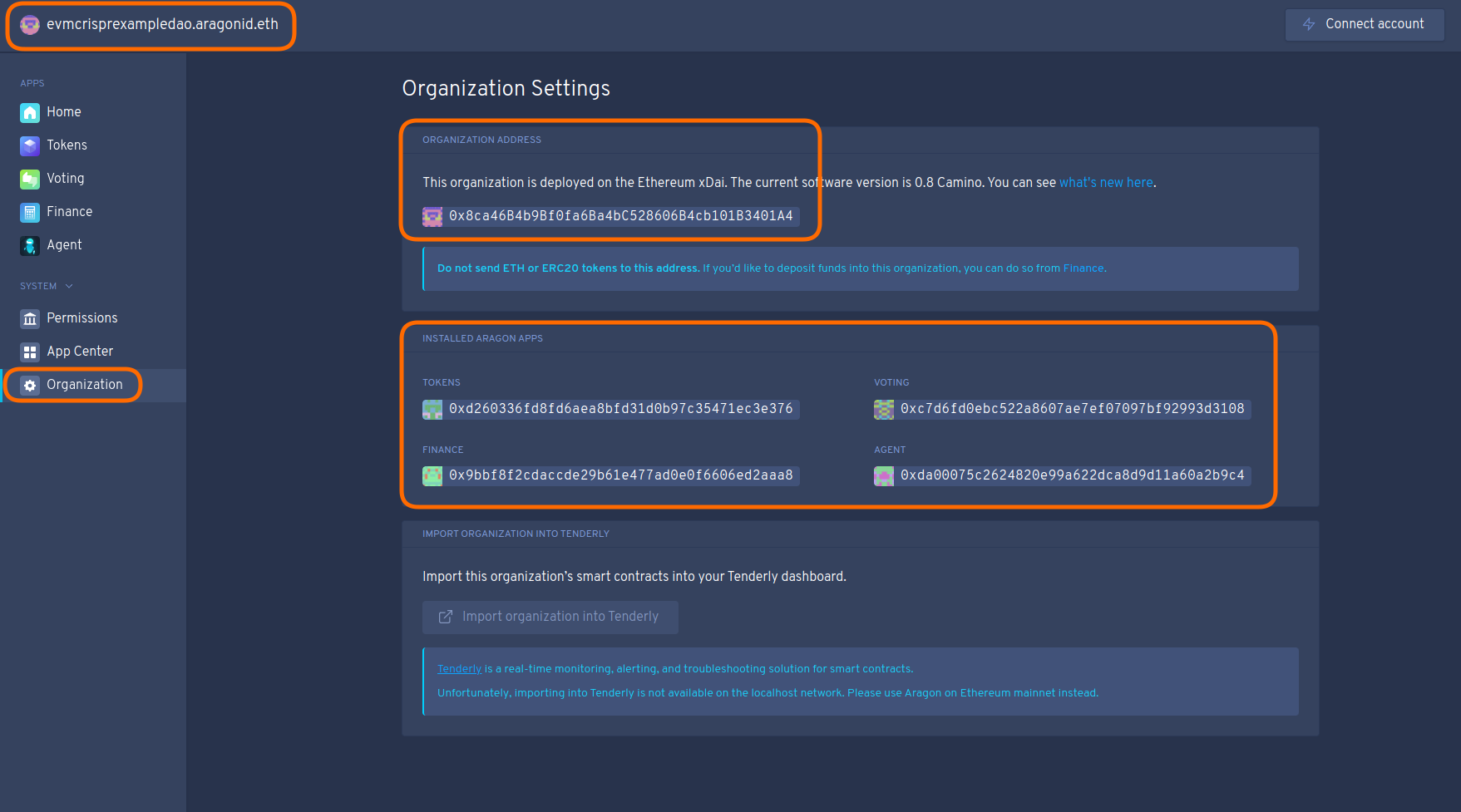Introduction to Aragon DAOs
AragonOS is the main framework that EVMcrispr has been tailored to interact with. Aragon DAOs are easily deployable and highly customizable governance platforms that can be launched using the Aragon Client on Mainnet or on Gnosis Chain via 1hive's Aragon Deployment.

This DAO structure allows a variety of native and custom apps to be plugged into the DAO using the system's Kernel, and each app's permissions in relation to other apps are dictated by the ACL.
Understanding Permissions
Permissions in the AragonOS may seem complicated, but they are essential for the security of your DAO. Let's take a look at the Permissions tab in an existing Aragon DAO:

You can see for each permission, and we have four parameters to be aware of:
- Action: The action that this permission is allowing to perform.
- On App: The associated app that performs the action.
- Assigned to Entity: The entity that has permission to make the app perform the specified action.
- Managed By: The entity that can grant and revoke this permission to other addresses (usually assigned to a voting app) in the future.
Types of Entities
An entity is an Ethereum Address. It can be specified using the Ethereum Address directly, using the entity identifier, or using an address that represents any entity.
- Specified Eth Address is expressed as the ETH address starting with
0x. Only this address will be the specified entity. - Identifier is the name of the internal Aragon App installed on your DAO, such as
voting,token-manager(representing any token holder), oragent. - Anyone is expressed as
ANY_ENTITYand can be any user visiting your DAO with a web wallet.
This is relevant to the grant and revoke commands detailed in each app's documentation.
The articles in this section will break down all the most common apps found in an Aragon DAO. Then, we'll show you all the actions that can be done via EVMcrispr to modify the DNA of your Aragon DAO.
If you want to go deep and learn more technicals of Aragon DAOs, you can check out the Aragon Developer documentation.
Finding DAO information
You should probably figure out where to send your scripts. Collecting essential DAO information such as the Organization Address and Application Addresses can be found in a typical Aragon DAO from the Organization page.

Loading the Module
You'll need to load the module to write EVMcrispr scripts for Aragon DAOs.
This module is for commands and helpers specifically related to the Aragon OS framework. Inside EVMcrispr it is referenced as aragonos. You can load it using this syntax:
load aragonos as <alias>
Here is an exhaustive list of all associated commands and helpers for aragonos:
Commands
- act
- connect
- forward
- grant
- install
- new-dao
- new-token
- revoke
- upgrade
Helpers
- @aragonEns
Learn more about modularity in EVMcrispr
The connect Command
Interacting with any Aragon DAO will require you to preface your script with the connect command. This will tell EVMcrispr which DAO to send the script to. You can also specify a forwarding path that defines through which apps we need to ask permission. The actions you want to execute in your script should be enclosed in parentheses ().
By default, an Aragon DAO will usually need to execute actions with permission from the voting app, creating a vote to execute your script. However, depending on your permissions, often you'll need to pass through the Token Manager, making sure you have DAO tokens, the Token Manager, which typically has permissions to create votes, would then forward to the voting app, creating a vote. Let's take a look at this example:
load aragonos as ar
ar:connect 0xaF810FaC58eD1B06A336cbc1f273fb0eBfB8a1EE 0x43acbd385e5d474330022635700ce0c706ad0ede 0x8e8ea49256421cf7f28d2f1170666da81e22e618 (
# inside here, add some actions you want your script to do
)
Referencing the addresses in the example Organization above, we're routing our script in this manner: Organization Address -> Token-manager App -> Voting App.
We can also make our lives much easier with some in-house syntax sugar.
load aragonos as ar
ar:connect mitchcorp token-manager voting (
# inside here, add some actions you want your script to do
)
It will connect us using the aragonID ENS name associated with the DAO. This can usually be found in the top left of the Aragon DAO navbar.
More on syntax-sugar in the Syntactic Sugar Article.
Nesting connect
Nested connect commands allow you to define DAO-to-DAO operations scripts and have access to different organizations’ apps inside a scope. You can reference an extra DAO’s app by their name, address, or nesting index.
Parameters
daoAddress: The organization address or Aragon ENS identifier of the DAO you wish to interact with.appName: The name of the Aragon app you wish to interact with.
Syntax
<daoAddress>:<appName>
For example:
load aragonos as ar
ar:connect mainDAO (
ar:connect subDAO tollgate token-manager voting (
# It grants mainDAO's voting app permissions to create votes in the subDAO's voting app.
grant _mainDAO:voting voting CREATE_VOTES_ROLE
# Here the nesting index "_1" is the same as "_myDAO".
grant _1:voting token-manager MINT_ROLE
)
)
forward
The forward command allows you to customize the forward path by not having to define it in the connect command. This can be helpful when creating scripts sent through a forwarding path composed of apps from different DAOs.
Syntax
forward <...path> ( <...commands> )
For example:
load aragonos as ar
ar:connect mainDAO (
ar:connect committeeDAO (
forward _mainDAO:token-manager token-manager (
# inside here, add some actions you want your script to do
)
)
)
Adding Context
Some apps using AragonOS v5, such as 1hive Disputable Voting, allow you to forward a set of actions with a context. In this app, the context will be included in the publicly displayed information for the vote. You can add context to your script with this syntax:
load aragonos as ar
ar:connect <DAOaddress> <forwardingPath> --context "Your context goes here" (
# inside here, add some actions you want your script to do
)
Directly Calling Functions
You can skip specifying the forwarding path. Instead, if any entity or the address connected to the EVMcrispr terminal has permission to perform a particular action, you can call it directly, and the syntax looks like this:
load aragonos as ar
ar:connect <DAOaddress> (
# inside here, add some actions you want your script to do
)
For example:
load aragonos as ar
ar:connect mitchcorp (
exec token-manager mint @me 100e18
)
Assuming ANY_ENTITY or my address already has the MINT_ROLE role, this would send 100 tokens from the Token Manager to my connected address.
Aliasing Multiple Apps in Aragon DAOs
If you have multiple instances of the same app installed, you can specify which app you want to interact with by a simple numbering nomenclature. For example, the first app installed on your DAO can always be referenced by <appName>:0, as in agent:0, finance:0, or token-manager:0. Any additional apps installed will have the following number appended to their name. So, if you install a second agent, it will be referenced by agent:1. If you install a third one, it will be referenced by agent:2, and so on.
Upgrading apps
This command upgrades the kernel’s base contracts of the defined apps so that those app proxies will point to a new implementation contract or a different version of the same app.
There are a few different ways to use this command:
Upgrade to Latest Version
If you want to upgrade all instances of an app to the latest version, use this syntax:
upgrade <appName>
For example:
upgrade finance
would upgrade all instances of the finance app to the latest version
Upgrade to Specific Version
If you would like to upgrade or downgrade all instances of an app to a specific version, you can use this syntax:
upgrade <appName> <version>
For example:
upgrade voting 1.0.0
It would upgrade (or downgrade, depending on your current version) the voting app to version 1.0.0.
Upgrade to Specific Contract
warning
This command could break the app we are upgrading, so be careful to check that the new implementation contract is compatible with the previous one.
To upgrade all instances of an app to a specified implementation contract, you can use this syntax:
upgrade <app> [contract]
For example:
upgrade agent 0x123456789abcdef123456789abcdef0123456789
It would change the proxy app's implementation contract to the specified contract address.